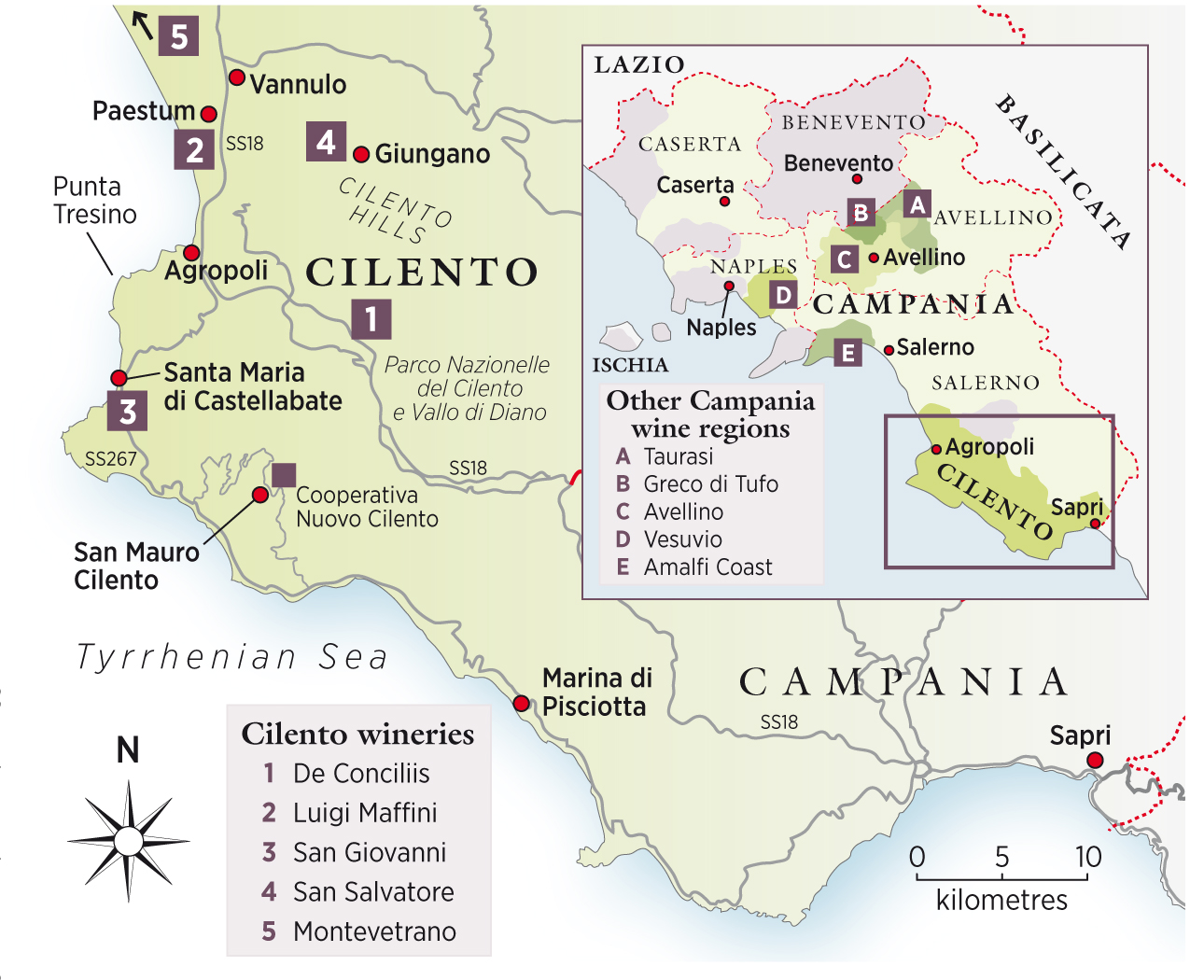Escape Campania's tourist hotspots and explore the unspoilt hilltop towns and fishing villages of this exciting wine region. Carla Capalbo shares her Cilento travel guide.
FACT FILE

Planted area 2,000ha
Main grapes White: Fiano, Falanghina, Greco, Trebbiano, Malvasia, Santa Sofia Red: Aglianico, Piedirosso, Barbera, Primitivo, Aglianico
Appellations Cilento DOC, Paestum IGT
Main soil types Flisch, a post-volcanic clay and limestone combination
Quick links:
The bounties of the Campania region go well beyond Naples and the stunning (but often touristy) Amalfi Coast. While the wines of the province of Avellino – including its three DOCGs, Fiano di Avellino, Greco di Tufo and Taurasi – are gaining global recognition, and wines from Vesuvio, Caserta and Benevento are becoming better known too, the province of Salerno has less well-known treasures to explore.
In Cilento, the most beautiful yet relatively undiscovered southern part of the region, a handful of fine producers are raising the bar for wines of local grapes Fiano, Aglianico and Piedirosso. The grey-green Cilento hills begin south of Salerno and stretch down from Paestum to Sapri, where they meet the region of Basilicata near Maratea. They’re a central part of the Parco Nazionale del Cilento e Vallo di Diano, Italy’s second-largest park and a UNESCO World Heritage Site. The park was established to protect this spectacular landscape from mass tourism and speculative building.
To many the Cilento landscape is reminiscent of Tuscany or Umbria before they were gentrified: all sloping olive groves and vineyards interspersed with small fields of chickpeas, tomatoes or fig trees. The native and noble pale Podolica cow is comfortable with the area’s dry summers, and grazes in the macchia mediterranea – the natural scrub that grows wild here as throughout southern Italy. It’s rich with wildflowers and aromatic plants: wild fennel, thyme, rock-roses and the ‘strawberry tree’, whose perfumed flowers are the source of the bees’ bitterest honey, here called corbezzolo. It goes surprisingly well with mature cheese, though not perhaps with the delicate ricottas of cow or buffalo milk that are produced in this area. Look for the Cilento’s unique mozzarella nella mortella: hand-stretched cow’s milk cheese wrapped in scented myrtle branches.
Head for the sea
The coast is some of Italy’s least spoiled, with rocky shores interrupted by small fishing villages such as Marina di Pisciotta or Sapri. Seafood is plentiful: family boats still set off at night to attract octopus and baby squid. At Pisciotta, fresh anchovies are caught using a type of net – la menaica – that dates back to ancient Greece. This area was part of Magna Grecia, as the majestic temples standing at Paestum attest. They’re as good as anything in Greece or Sicily and, if you go off season or early in the day, you’ll have them practically to yourself. In 1944, when the Allies landed on Paestum’s beaches, all they found in the flat marshes surrounding the temples were buffaloes: this is one of only two areas in Italy in which mozzarella di bufala DOP is made.
As for wine, it was long grown as one of many crops on family farms, but in the last 20 years a small number of visionary estates have dedicated themselves to making premium wines, with fine results. People like Bruno De Conciliis and Luigi Maffini have inspired a new batch of young producers with wines of character that reflect this land and complement its delicious food. Their wineries are visitable by appointment: the people you’ll meet also make the wines, so book ahead to get time with them. The best way to visit is by car.
Culture of innovation
The De Conciliis family are pioneers. ‘It’s exciting to be making wine in an area with little oenological tradition,’ says Bruno De Conciliis, who, with his brother and sister run the family estate at Prignano Cilento (www.viticoltorideconciliis.it). A natural experimenter, De Conciliis’ range of exciting wines has loyal followers; it includes red and white Donnaluna, and Selim, the country’s first sparkling Aglianico, dedicated to jazz musician Miles Davis.
Just south of Agropoli, Mario Corrado and Ida Budetta have chosen an isolated, breathtaking position for their vineyards, with high views over the sea at Punta Tresino. Their estate, San Giovanni, has four hectares of vineyards and is making its name for Fiano and a Piedirosso that maintains its fresh, natural character in what are often very hot summers here (www.agricolasangiovanni.it).
Luigi Maffini also works by the coast, at Cenito, near Castellabate (www.luigimaffini.it). He ages his mineral Fianos, Kratos and Pietraincatenata in wood. Maffini’s 11ha of vineyards are certified organic, and his new cellar will be a fitting home for them.
Nearby at Giungano, hotelier Giuseppe Pagano of San Salvatore estate has launched an ambitious farm project of buffaloes, extra virgin olive oil and vines (www.sansalvatore1988.it). With 16ha, the land is worked organically with biodynamic treatments, but there’s nothing rustic about the wines.
If you decide to drive north to the Amalfi Coast or Salerno from Cilento and want to meet one of the icons of Campanian winemaking, Silvia Imparato’s Montevetrano is located in the hills east of Salerno. Her Bordeaux blend with added Aglianico remains one of the region’s most famous and historic reds (www.montevetrano.it) and her winery is one of the region’s most beautiful, with an elegant agriturismo attached (www.lavecchiaquercia.it).
How to get there
By plane to Naples, then a rented car – about 90 minutes’ drive if you take the autostrada. Public transport (train or coach from Naples) will get you to Paestum-Capaccio, but not into the Cilento hills.

Written by Carla Capalbo







